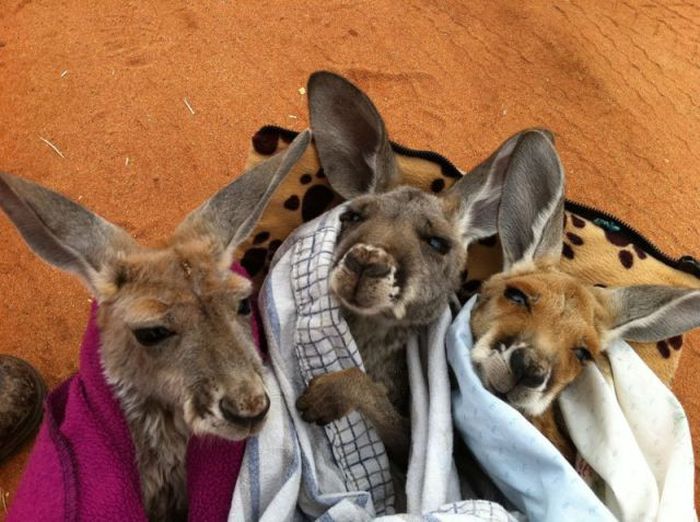|
|
Orphaned Baby Kangaroos
|
In addition, there are about 50 smaller macropods closely related to the kangaroo in the family Macropodidae. Kangaroos and other macropods share a common ancestor with Phalangeridae from the mid-Miocene. This ancestor was likely arboreal and lived in the canopies of the extensive forests that covered most of Australia at that time, when the climate was much wetter, and fed on leaves and stems. From the late Miocene though the Pliocene and into the Pleistocene the climate got drier which lead to a decline of forests and expansion of grasslands. At this time there was a radiation of macropodids characterised by enlarged body size and adaptation to the low quality grass diet with the development of foregut fermentation. The most numerous early macropods, the Balbaridae and Bulungmayinae, went extinct in the late Miocene around 5–10 mya. There is dispute over the relationships of the two groups to modern kangaroos and rat kangaroos. Some argue that the balbarines were the ancestors of rat kangaroos and the bulungmayines were the ancestors of kangaroos. while others hold the contrary view.
The middle to late bulungmayines, Gungaroo and Wanburoo lacked digit 1 of the hind foot and digits 2 and 3 were reduced and partly under the large digit 4, much like the modern kangaroo foot. This would indicate that they were bipedal. In addition their ankle bones had an articulation that would have prohibited much lateral movements, an adaptation for bipedal hopping. Species related to the modern grey kangaroos and wallaroos begin to appear in the Pliocene. The red kangaroo appears to be the most recently evolved kangaroo with its fossil record not going back beyond the Pleistocene period, 1–2 mya.
Europeans have long regarded kangaroos as strange animals. Early explorers described them as creatures that had heads like deer (without antlers), stood upright like men, and hopped like frogs. Combined with the two-headed appearance of a mother kangaroo, this led many back home to dismiss them as travellers' tales for quite some time. The first kangaroo to be exhibited in the western world was an example shot by John Gore, an officer on Captain Cook's Endeavour in 1770. The animal was shot and its skin and skull transported back to England whereupon it was stuffed (by taxidermists who had never seen the animal before) and displayed to the general public as a curiosity. The first glimpse of a kangaroo for many 18th-century Britons was a painting by George Stubbs.
|
|









